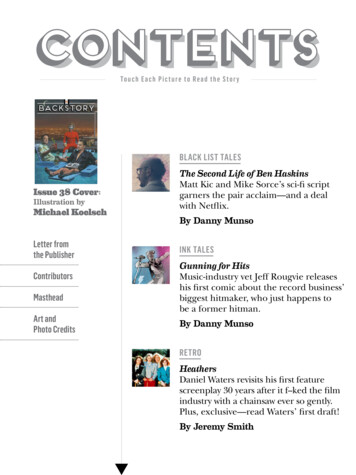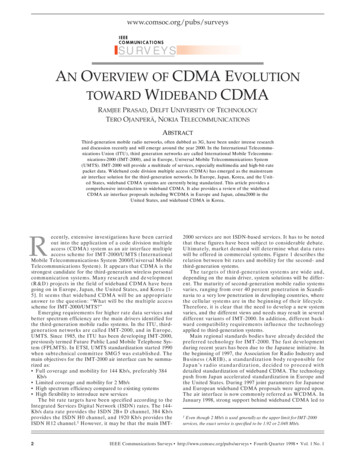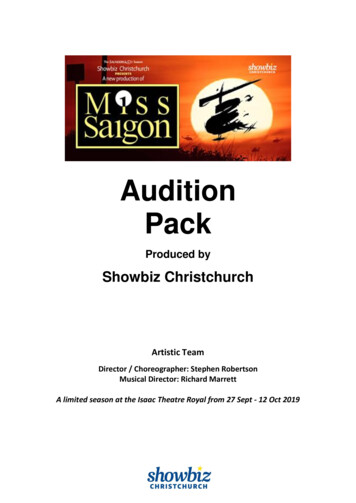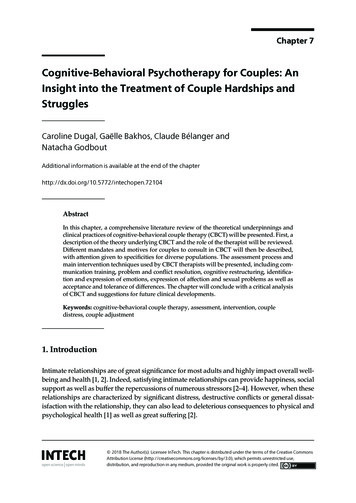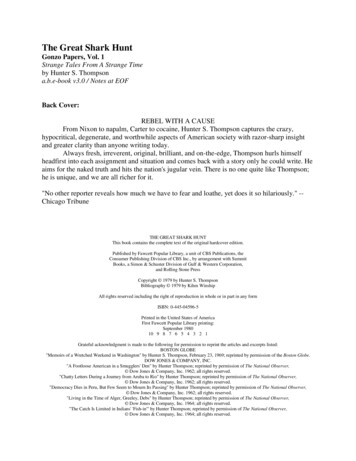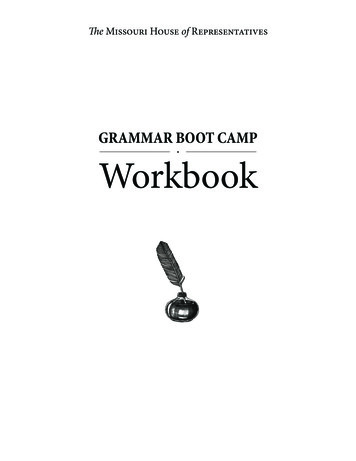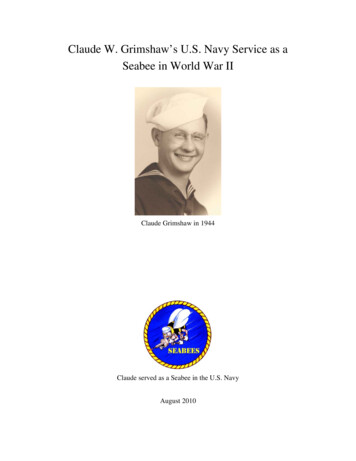
Transcription
Claude W. Grimshaw’s U.S. Navy Service as aSeabee in World War IIClaude Grimshaw in 1944Claude served as a Seabee in the U.S. NavyAugust 2010
Claude W. Grimshaw’s U.S. Navy Service as aSeabee1 in World War IIbyThomas W. GrimshawSon of Claude GrimshawAugust 2010Contents1.Introduction . 32.Claude’s Life before the Navy. 53.Enlistment and Training . 94.Deployment to the Aleutian Islands . 105.Marriage to Phyllis Lorraine Rogers in San Jose, California . 136.Deployment to Saipan . 157.Visit to Saipan by Claude’s Half-Brother, Stanley Bice . 188.Deployment to Okinawa after Saipan. 219.Navy Separation and Service Record . 2310.Return to Civilian Life . 2511.Claude’s World War II Scrapbook and Other Artifacts. 2912.Interment at Black Hills National Cemetery . 33Appendix A. Wikipedia Article: The Seabees in World War II . 341“Seabee” is the term used for Construction Battalions (CBs) o the U.S. Navy.2
1. IntroductionClaude Walter Grimshaw entered the US Navy in July 1942, eight months after Pearl Harbor, atage 21. He served until November 1945, a total of about three years and four months, duringwhich he participated in campaigns in the Pacific Theater. Claude was assigned to NavalConstruction Battalions, commonly referred to as "Seabees", and he held rank of ChiefBoatswains Mate (CBM). He entered on active duty in Seattle, Washington, where he had movedto from his home in Oacoma, South Dakota in about 1940.After receiving Seabee training at Camp Allen, near Norfolk, Virginia, in August, Claude wasdispatched to the Aleutian Islands with the 21st US Naval Construction Battalion. The unitarrived at Dutch Harbor in October 1942 and remained in the Aleutians until November 26,1943, when it was deployed to Camp Parks near San Francisco. Claude departed the Aleutianstwo or three days prior to the 26th and was on the Liberty Ship John P. Gaines when it broke upat sea on November 24. Most of the passengers, including Claude, were rescued. He wasassigned to the 89th NCB while at Camp Parks.The next record of Claude was his marriage to Phyllis Rogers in San Jose, California on April 1,1944, about four months after leaving the Aleutians. Phyllis traveled from Oacoma for themarriage. The 89th Construction Battalion, a replacement pool at Camp Parks, was demobilizedon July 15, 1944, and Claude was apparently transferred to the Construction BattalionReplacement Depot (CBRD) – his third assignment – at that time.Claude was then assigned to the 17th Naval Construction Battalion, which departed for Saipan inSeptember 1944, about two months after the main battle on the island had taken place in July. Heapparently remained on Saipan until early 1945, because his half-brother Stanley Bice, who wasassigned to a US Army Air Force maintenance unit on Tinian, visited Claude on Saipan in 1945.Sometime after meeting with Stanley, Claude departed with his Seabee unit for Okinawa, wherethe main action took place from April to mid-May 1945. Claude reported to his family that hewas injured in action while attempting to rescue a US Marine who had fallen from a rope ladderwhile transferring to a troop landing ship. It has not yet been confirmed, but it is likely thatClaude was injured while piloting an LST – a common assignment for a CBM in the Seabees –during or after the 2½-month long battle on Okinawa.Claude was released from active duty in Minneapolis in November 1945 and joined his newfamily (his first son was born during the preceding March) in his hometown of Oacoma, SouthDakota. After attempting farming for a while, Claude became involved in the earth trenchingthen in the earth boring and water well drilling business, which he continued throughout hisprofessional life.According to Claude’s separation record, he served in five units -- a training battalion in Norfolkfollowed by the 21st and 89th Battalions, the Construction Battalion Replacement Depot (CBRD)at Camp Parks, California, and finally the 17th Battalion. A brief history of these units has beenfound in the internet and is shown below.21ST BATTALIONFormed at Norfolk, the 21st Battalion reached Hueneme Sept. 22, 1942, and embarked for Alaska Oct. 10.The Battalion operated from Dutch Harbor for 14 months, with detachments on Atka, Adak and Ogilaga.The 21st returned to Camp Parks Dec. 14, 1943. On its second tour of duty, the 21st reported to the Seventh3
Regiment July 27, 1944, at Pearl Harbor, and operated at Moanalua, Intrepid Point and Waipio Point untilthe Spring of 1945, when the Battalion moved on to Saipan and the Ryukyus to finish out the war.89TH BATTALIONFormed at Camp Allen in February 1943, the 89th Battalion was transferred to Camp Peary later that month.On April 21 it was moved to Camp Parks. After serving more than a year as a replacement pool, the 89thwas decommissioned at Camp Parks July 15, 1944.17TH BATTALIONThe 17th Battalion was commissioned at Camp Allen Aug. 8, 1942, and transferred to Camp Bradford thenext day. On Sept. 1 the outfit was moved to Gulf-port, Miss, and three weeks later to Davisville, R. I.Embarking at Staten Island on Oct. 1, the Battalion arrived at Argentia, Newfoundland, on Oct. 12. OnMarch 14, 1943, the ranks were swelled by the addition of CBD 1004, filling the Battalion complement.Returning home, the unit sailed from Argentia on Nov. 17, 1943, arriving at Davisville Nov. 20. On May 9,1944, the outfit entrained for Port Hueneme, arriving May 14. After a month at Hueneme, and three monthsat nearby Point Mugu, the Battalion started its second overseas tour, sailing from Port Hueneme Sept. 11.1944. Saipan was reached Oct. 6, 1944. After the Okinawa invasion the outfit was transferred there.Source: %20Battalions.htmA description of the other unit in which Claude served (after training) was also been found and isshown below:CBRD Camp ParksCamp Parks was a Constructions Battalion Replacement Depot (CBRD): the rest camp and training facilityfor Seabee units that had returned from the Pacific.Source: 3.htmThanks go to Fay Bice, Stanley's wife and Claude's sister-in law, for providing information andphotos for this booklet. Thanks also to Sam Bice, Fay’s son, for making accessible materials inJoe Bice's trunk of family heirlooms, which included several letters from Claude. Much of theinformation and photos presented here is from photo albums and scrapbooks prepared by Claudeand Phyllis. The most important one for Claude’s World War II experience is a combined albumand scrapbook described in Section 11 of this booklet. Much of the information on the trainingand Alaska deployment of the 21st NCB is from a “Souvenir Annual 2 ”.2Nease, Earl D., ed., 1943. 12st Naval Construction Battalion, 1942-1943: Souvenir Annual. Publisher NotIdentified. 18 pages.4
2. Claude’s Life before the NavyClaude Walter Grimshaw was born in Oacoma, South Dakota, in October 1920. Freda Grimshawwas Claude's mother; his father, also named Claude, died from pleurisy several months beforeclause birth. A picture of Freda with her older son, George, and Claude is shown below.After she was widowed, Freda married Joseph Bice, and the couple had one son, Stanley, who isshown below (left) with his half-brothers, Claude T. (center) and George Grimshaw.5
Claude graduated from high school in Oacoma in 1938. He participated in Civilian’s MilitaryTraining Camps at Fort Snelling, near Minneapolis, Minnesota that summer and the followingsummer. He completed the "Red" course in August 1938 and the "White" course in August 1939.Shown below is a photo believed to be one of the two classes. The photo is the left half of theoriginal, in which Claude indicates his location with a small "x". Claude also signed the back ofthe photo, the signature is shown below the picture. The flag with crossed rifles indicatesCompany A of an infantry brigade.An image of Claude’s certificate of completion of the Red course in 1938 is shown below.6
Fort Snelling was visited by the author of this booklet in June 2010. The photos below are of thetower and enclosing wall of the original fort as well as the parade ground inside the enclosure.The third photo is of a building outside the enclosure that is no longer in use but may well havebeen the barracks where Claude stayed in 1938 and 1939.Sometime between August 1939 in November 1940, Claude left Oacoma for Bremerton,Washington, where his brother, George, and wife, Judy, were living and had jobs at the NavyYard. Shown below is a postcard from Claude to his parents in Oacoma showing that he hadarrived there by November 29.7
Claude may have worked at the 80 Yard, but it is known from family learned that he wasengaged as a deep sea diver, and he was also a pilot of a tugboat in Puget Sound according to hisU.S. Navy records.Another postcard shows that Claude crossed the Tacoma Narrows Bridge just a few hours beforeit collapsed on November 7, 1940 as shown in the images below8
3. Enlistment and TrainingWorld War II began for the US shortly after the Japanese attacked Pearl Harbor on December 7,1941. That enlisted in the U.S. Navy seven months later, in July 1942, at which time he wasworking for the geek Ramsey Company as a tugboat operator. He was assigned to the 21st NavalConstruction Battalion (a unit of the "Seabees") and received his training at Camp Allen, nearNorfolk Virginia. The 21st NCB was actually commissioned when the training of its memberswas completed on August 6. An image of the unit’s logo from its “Souvenir Manual 3 is shownbelow.After training, the 21st NCB traveled by train back to the West Coast, to Port Hueneme inSouthern California, where furloughs were granted before deployment to the Pacific Theater.The photo of Claude shown below has not yet been dated, but is believed to have been takenduring his first year of service. The insignia indicating his rank shows that he was not yetpromoted to a “big” Chief Boatswain’s Mate. Note the signature in the lower left corner, “LoveClaude”.3[Souvenir Manual citation]9
4. Deployment to the Aleutian IslandsThe 21st Seabees arrived at Dutch Harbor in the Aleutians, where the Japanese had dropped afew bombs several months earlier, about the same time that they captured the islands of Attu andKiska. Details of Claude's responsibilities and activities while in the Aleutians are not known,although it is clear he was assigned to the island of Adak, as indicated in the image below from anewspaper article. Claude’s handwritten entry indicates that he lived in a Quonset hut on Adak.The Quonset hut was a universal container used by the Seabees for living, working, storage andother purposes.While stationed in Alaska, Claude wrote a letter his parents, which is shown below. The date,September 27, 1943, was about two months prior to his departure from Alaska.10
Claude remained with the 17th Naval Construction Battalion in Alaska for about 14 months, afterwhich he was assigned to the 89th NCB (a recuperation and training unit at Camp Parks, near SanFrancisco) according to his service record. He left the Aleutians in late November 1943 and wason the Liberty Ship John P. Gaines when it broke in half on the island of Big Koniuji, one of theShumigan Islands west of Kodiak. The breakup occurred on November 24, which was just twodays before the 17th Seabees left Dutch Harbor. A newspaper article describing the fate of theJohn P. Gaines is shown below with Phyllis Grimshaw’s handwritten description in thescrapbook where the article was stored.11
A photograph that accompanied the newspaper article on the sinking of the John P. Gaines isshown below.12
5. Marriage to Phyllis Lorraine Rogers in San Jose, CaliforniaThe next record we have of Claude is in April 1944, four months after leaving Alaska, when hemarried Phyllis Rogers in San Jose, California, which – like Camp Parks – is in the SanFrancisco area. Phyllis had traveled there by train from her (and Claude's) hometown of Oacoma,South Dakota. A photo of Claude and Phyllis, taken in San Jose within a month of theirmarriage, is shown below.An image of Claude and Phyllis Grimshaw’s marriage license is shown below.13
A postcard depicting the Hotel Sainte Claire in San Jose (shown below) may have been kept inan album by Claude and Phyllis possibly because it was their honeymoon hotel/The following photo of Claude must have been taken in the same timeframe, as the photo studiowhose stamp appears on the back of the photo is located in San Jose.14
6. Deployment to SaipanClaude and Phyllis Grimshaw were together until about June 1943, as their first son, Thomas,was born the following March 23. Therefore sometime during July or August, Phyllis returned toOacoma, where she lived with her sister-in-law, Judy Grimshaw, pending Claude’s return fromthe war. Claude, who was assigned to the 21st Naval Construction Battalion after CBRD CampParks, remained stateside until September (his former unit, the 17th NCB went to Hawaii in July).He received his orders for his next assignment on September 1 as indicated in the letter below tohis parents.Claude crossed the International Date Line on September 25, as indicated by his membershipcard for the "Imperial Domain of the Golden Dragon" shown below.15
The 21st NCB arrived on Saipan in the Mariana Islands on October 6, 1944, which was aboutthree months after the defeat of the Japanese. Presumably he was involved in the post-battlecleanup and reconstruction. A picture of the camp on Saipan where Claude was stationed isshown below.“Our camp in Saipan taken from the air”“Claude on Saipan”16
The photos of Claude shown below were probably taken sometime later, perhaps after the tentshad been replaced by more permanent Quonset huts.“The big chief by Quonset hut 1944”17
7. Visit to Saipan by Claude’s Half‐Brother, Stanley BiceOne of the highlights of Claude's World War II experience was a surprise visit from his halfbrother, Stanley Bice, while he was on Saipan in 1945. Stan was assigned to a maintenance unitof the U.S. Army Air Corps on Tinian, a nearby island of the Marianas. He had heard thatClaude's unit, the 21st Seabees, was on Saipan, and (according to his wife, Fay Bice) seized anopportunity to go to Saipan to assemble a truck. There, he found Claude, who later said it was"the best of my life" when he saw Stan. The photos shown below are of Stan and Claude whilethey were together on Saipan.“Stan and Claude in Camp on Saipan”Stan and Claude by shrine”Stan and Claude by Jap 75”18
“Stan and Claude on Saipan”“Claude and Stan by Hirohito statue on Saipan”Stan subsequently continued his assignment on Tinian and had his photo taken (shown below)sometime after the atomic bomb was dropped on Hiroshima on August 6, 1945.19
Fay Bice, widow of Stanley, indicates that the carved figure shown below is from Saipan.Apparently, Stan made arrangements for it to be shipped home in South Dakota while he wasvisiting Claude. The piece, which is about 18 to 24 inches high, is in Fay’s possession in RapidCity. The language or meaning of the figure have not yet been interpreted.20
8. Deployment to Okinawa after SaipanSometime after his meeting with Stan on Saipan in 1945, Claude departed with the 21st Seabeesfor Okinawa. Records of his experience there have not yet been found, although the paragraph onthe 21st Seabees in the Introduction to this booklet seems to indicate that the unit arrived after themain battle, which was very intense and lasted from April through mid-June, was over. Shownbelow are photos apparently taken by Claude while he was on Okinawa.“Our landing from LSTs on Okinawa. Notice Jap machine gun nest and pill box. I came on888” (Note: “888” is the number on the craft on the right.)“Ishikawa on Okinawa”“Native hut on Okinawa”“Okinawa cart”It was well known in the family that Claude had been injured during landing operations in thePacific operations during World War II. It seems likely that as a Chief Boatswain’s Mate (CBM)he was piloting an LST carrying US Marines from troopships to the beach. According to family21
lore, Claude – while piloting the landing craft – observed a Marine fall from a rope ladderleading from a troopship to the LST. Claude dove or jumped into the water in an unsuccessfulattempt to save him the Marine and was caught between the troopship and LST, resulting in abroken collarbone and several broken ribs. It was also known in the family that Claude was in ahospital somewhere on the West Coast for several weeks recovering from his injuries.It has not yet been proven that Claude saw action on Okinawa and was injured as describedabove, but the scenario seems most likely in light of what was known in the family and has beenfound in his World War II service record.22
9. Navy Separation and Service RecordClaude received his discharge from the U.S. Navy Separation Center in Minneapolis onNovember 10, 1945 – coincidentally at or close to the location of his para-military training atFort Snelling, six or seven years earlier. His Notice of Separation (shown below) includes thefollowing facts: Claude served from July 16, 1942 to November 10, 1945, a total of 3 years, 3 months and25 days. His assignments included: 1) Naval Construction Training Center at Norfolk Virginia; 2)the 21st US Naval Construction Battalion; 3) the 89th Construction Battalion; 4) theConstruction Battalion Replacement Depot (CBRD), Camp Parks, California; and 5) the17th Naval Construction Battalion. His ranks were: 1) Boatswain's Mate First Class; 2) QM1/c; 3) Chief Boatswain’s Mate(AA); 4) Chief Boatswain's Mate (T) (CB). He was a tugboat operator working for Rumsey Puget Sound in Seattle when he enlisted. He completed three weeks of diving school.The Notice of Separation is shown below in two parts, followed by Claude’s U.S. Navyidentification card.23
24
10. Return to Civilian LifeAfter his discharge, Claude returned to his home town of Oacoma and joined his wife, Phyllis,and eight-month-old son, Tommy. Phyllis and Tommy are shown below when he was just a fewweeks old.The young family began their life together on a farm, apparently from Joe and Freda Bice, on theMissouri River “bottom” a few miles downstream from Oacoma. The house and outbuildings,shown below, were on the edge of the floodplain and at the foot of the slope of the MissouriRiver breaks.“Our house on river at Oacoma”25
The family remained on the farm for a few years as indicated on the photo below, which appearsto have been taken near the house in the photo on the previous page and is labeled “1948” in itsalbum. Since Claude’s younger son, Joey, was born in December 1947, he must have been just afew months old in the photo. Tommy would have been about three years old.“1948”26
Claude decided that “he was not a farmer” (according to family lore) and the family moved toOacoma by 1951, when Tommy started the first grade. Claude became involved in the earthtrenching business, first with a small Jeep-mounted chain-driven trencher (“Jeep Digger”) andthen with a larger truck-mounted backhoe (“Bantam Backhoe”). Pictures of the Jeep Digger andBantam Backhoe are shown below.“Our Jeep Digger”“Claude”“Jan 1952”27
During this timeframe, Claude and his half-brother, Stan, became familiar with a large-diameterearth-boring machine while working on a crew at a manganese mine on the Missouri river bluffsnear Oacoma. Stanley, shown below (right) near the boring machine at the mine, had the idea ofusing the rig for water well drilling.Claude and Stan subsequently formed well-drilling companies, at first together and laterseparately, and drilled wells with rigs of this design throughout South Dakota. Pictures of Claudedumping the boring bucket of one of the rigs are shown below. Later models were equipped withan arm that had a hydraulic ram and cable apparatus for pulling the bucket for dumping, whichgreatly reduced the manual labor required.“Claude, 1954”Claude developed new drilling methods (“reverse circulation”) that were widely appliedthroughout the U.S. and the world. In about 1961, Claude sold his drilling company (he wasliving with his family in Sioux Falls by this time) and accepted a job in the Los Angeles area.From there, Claude traveled worldwide as a consultant and earth drilling equipment salespersonfor many years before his retirement to Colorado in the late 1970s or early 1980s.28
11. Claude’s World War II Scrapbook and Other ArtifactsApparently, not long after Claude joined his family in Oacoma, he and Phyllis put together acombined scrapbook and photo album with pictures and other items to document his World WarII experiences. This scrapbook is the source of many of the images in this booklet. An image ofthe front cover is shown below.The scrapbook has 33 pages of materials (and several blank pages not used), a booklet mountedon the inside back cover, and a number of loose (unmounted) items. The contents of the albumare summarized as follows:PagesDescription1-7Saipan photos by Claude and friends, including Douglas Thomas Brown and Stanley Bice.8Three postcards. May include hotel where Claude and Phyllis stayed in San Jose.9Alaska newspaper photos. Annotated by Claude with "My Home in Adak").10-11Japanese currency.12Two photos, possibly from a deceased Japanese soldier. Japanese newspaper.13Saipan and Okinawa photos.14-16Okinawa photos, none with Claude. Also, five loose photos from the album.17Japanese buttons, cigarettes and other memorabilia.18-21Saipan battle action photos, apparently taken prior to Claude’s arrival in October.22Claude's U.S. Navy identification. Also, "Imperial Domain of the Golden Dragon" card,signifying that Claude crossed the International Date Line on September 25, 1944. Navy29
uniform insignia signifying clouds rank as a Boatswains Mate and Chief Boatswains Mate.Plastic tag with "Super Mole” engraved.23Newspaper articles, including wreck of Liberty Ship John P. Gaines, in November 1943.This is the ship that Claude was on as he was departing Alaska.24Footprints and lock of hair -- "Tommie Grimshaw – 9 days old"25"I Remember" – poem to Claude from Mary Alice McElroy, 1942 (probably while he wasin training at Roanoke, Virginia).26Claude’s letter of discharge, with original signature of James Forrestal, November 28,1945.27-31Pacific island wartime photos, without captions, apparently taken by Claude.32Two group photos, apparently graduation ceremony for Seabee training in RoanokeVirginia (subsequently identified as Company A the 21st Battalion from the booklet insidethe back cover).33"The Song of the Seabees" music sheet.LooseMaterials[In preparation.]Inside BackCover"21st US Naval Construction Battalion, 1942-1943, Souvenir Annual". Records theinitiation of the Battalion on August 28, 1942 after training at Camp Allen near Norfolk,Virginia. The Battalion traveled from Roanoke to Port Hueneme, California in Septemberand then to the unnamed port of embarkation in October, 1942. The 21st Battalion wasstationed at Dutch Harbor on the island of Unalaska in the Aleutian Islands. Claude spent atleast part of his tour of duty on the island of Adak before apparently departing inNovember 1943 on the Liberty Ship John P. Gaines.One of the items in the scrapbook is an oversize piece of cloth and probably made of parachutefabric, signifies the presence of the Seabees in the Mariana Islands, which include Saipan andTinian. An image of the cloth is shown below30
The scrapbook includes the sheet music for “The Song of the Seabees”; the cover page is shownbelow. The words to the song are shown next to the image. If you are looking at this booklet as aMicrosoft Word document, double-click on the speaker symbol below to listen to the music.Words by Sam M. LewisMusic by Peter de RoseWe're the Seabees of the NavyWe can build and we can fightWe'll pave the way to victoryAnd guard it day and nightAnd we promise that we rememberThe "Seventh of December"We're the Seabees of the NavyBees of the Seven SeasThe Navy wanted menThat's where we came inMister Brown and Mister JonesThe Owens, the Cohens and FlynnThe Navy wanted moreOf Uncle Sammy's kinSo we all joined upAnd brother we're in to winA crucifix, apparently made of brass, is also in the scrapbook. An image is provided below. Thesignificance of the crucifix here is not fully understood, but – like other items in the scrapbook –it may be a souvenir from a deceased person on Okinawa. Collecting such battlefield souvenirswas apparently common practice at that time and place.31
A patch or insignia showing Claude’s rank as “The Big Boatswain” (probably signifying a ChiefBoatswain’s Mate rather than just a Boatswain’s Mate) is in the album. An image is shownbelow.It was also apparently common practice during World War II for mothers of newborns to senditems related to the child to the serviceman husband in faraway places. Phyllis sent such an itemfor son Tommie, who was born on March 23, 1945. An image is shown below.Claude was probably on Saipan when he received the item, as the 17th NCB apparently didn’t’arrive on Okinawa until after the battle for the island was won by the Americans in June.32
12. Interment at Black Hills National CemeteryClaude Grimshaw smoked cigarettes for most of his adult life – a habit he may have picked upduring his wartime experience, as did many other veterans. Not long after retiring, he had ananeurysm of the descending aorta at about the level of the navel. After undergoing surgery for anaortic replacement that extended to the femoral arteries, his health declined dramatically. Hisrenal arteries became occluded after the surgery, and he became dependant on dialysis, includingcontinuous ambulatory peritoneal dialysis (CAPD), which increased his mobility andindependence. The abdominal tubing for the CAPD was inadvertently pulled out one night, andClaude underwent surgery for its replacement. He died of heart fibrillation on the operating tablein Pueblo, Colorado, on April 4, 1983, at age 62.At his request, Claude was buried at Black Hills National Cemetery near Sturgis, South Dakota.His wife, Phyllis, died on May 27, 2007 subsequent to removal of a brain tumor and is buriedwith Claude. Shown below is the entrance to the cemetery. Claude and Phyllis Grimshaw’s graveis behind the left pillar. The photo – and the two below it – were taken in June 2010.Claude’s grave marker is shown below with Tom Grimshaw, Claude’s older son and author ofthis booklet. JoAnne Grimshaw, Tom’s wife, is shown with the reverse side of the marker, whichhas the entry for Phyllis.33
Appendix A. Wikipedia Article: The Seabees in World War IIThe Wikipedia article on the Seabees’ role during World War II provides excellent context forthe Claude Grimshaw’s military career. The article is reproduced in part below. The paragraphsmost relevant to Claude are shown in bold font.Contents1. Creation2. The first Seabees3. World War II3.1. The Atlantic theater3.2. The Pacific theater4. After the war1. CreationUnder international law civilians were not permitted to resist enemy military attack. Resistance meant summaryexecution as guerrillas. The need for a militarized Naval Construction Force to build advance bases in the war zonewas self-evident. Therefore, Rear Admiral Ben Moreell determined to activate, organize, and man Navyconstruction units. On 28 December 1941, he requested specific authority to carry out this decision, and on 5January 1942, he gained authority from the Bureau of Navigation to recruit men from the construction trades forassignment to a Naval Construction Regiment composed of three Naval Construction Battalions.WWII recruitment posterAn urgent problem confronting the Bureau of Yards and Docks was who should command the constructionbattalions. By Navy regulations, military command of naval personnel was limited to line officers. Yet it wasdeemed essential that the newly established construction battalions should be commanded by officers of the CivilEngineer Corps who were trained in the skills required for the performance of construction work. The bureauproposed that the necessary command authority should be bestowed on its Civil Engineer Corps officers. However,the Bureau of Naval Personnel (successor to the Bureau of Navigation) strongly objected to this proposal.Despite this opposition, Admiral Moreell personally presented the question to the Secretary of the Navy. On 19March 1942, after due deliberation, the Secretary gave authority for officers of the Civil Engineer Corps to exercisemilitary authority over all officers and enlisted men assigned to construction units. The Secretary's decision, whichwas incorporated in Navy regulations, removed a major roadblock in the conduct of Seabee operations. Of equalimportance, it constituted a very significant morale booster for Civil
The Quonset hut was a universal container used by the Seabees for living, working, storage and other purposes. While stationed in Alaska, Claude wrote a letter his parents, which is shown below. The
